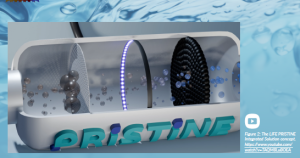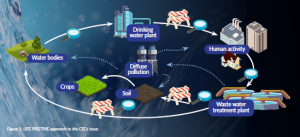LIFE PRISTINE pioneers an advanced water treatment system designed to eliminate over 80% of emerging contaminants from both drinking water and wastewater, integrating innovative technologies to ensure cleaner and safer water for future generations.
Over the past few decades, the protection of water resources has emerged as a paramount concern for public, scientific and political institutions globally. Clean water is indispensable not only for human health but also for the sustainability of ecosystems. In response, a variety of measures have been implemented to safeguard water bodies from both conventional pollutants and the so-called contaminants of emerging concern (CECs). These measures include significant investments in scientific research that are driving technological advancements.
The European Union defines CECs as substances that have the potential to enter the environment and cause adverse ecological and human health effects. However, these compounds are still largely unregulated, and their fate and potential effects are still under study.
CECs can be broadly classified into several categories of chemicals, such as pharmaceuticals and personal care products (PPCPs), cyanotoxins, nanoparticles, illicit drugs, antibiotics, hormones, disinfection by-products (DBPs), benzotriazoles, 1,4-dioxane, perfluoroalkyl chemicals (PFAS), microplastics and antibiotic resistance genes (ARGs).
Some CECs have been shown to present risks for human health, such as immune system impairment or endocrine disrupting effects, carcinogenicity, and/or mutagenicity, and they are related to infections caused by multi-drug resistant bacteria.
Understanding CECs’ toxicity (short and long-term), as well as their occurrence, mobility, degradation and bioavailability, is still a challenge. It is needed to protect human health and the environment since several contamination cases continue to be unknown due to the limitation of detection techniques, regulatory policies and impact assessments.
In this context, the LIFE PRISTINE project aims to deliver a cutting-edge water treatment system that can efficiently and effectively remove a wide range of CECs both from drinking water and wastewater. The objective is to eliminate over 80 per cent of these types of pollutants, going beyond existing legislation.
By integrating advanced technologies and innovative processes, the project seeks to enhance the quality of treated water, ensuring its safety for consumption and environmental discharge.
Key objectives of LIFE PRISTINE
- Development of advanced treatment technologies: the project focuses on creating an integrated system that combines physical and chemical treatment processes to target various families of CECs.
- Demonstration and validation: implementing the developed technologies in two real-world scenarios to validate their efficacy and scalability.
- Sustainability and cost-effectiveness: ensuring that the solutions are not only effective but also economically viable and environmentally sustainable. In this sense, the aim is to lower 30 per cent of operational expenses from conventional comparable technologies.
A glance at the PRISTINE Integrated Solution
The LIFE PRISTINE project is built on a foundation of innovative technologies and interdisciplinary approaches. By leveraging the latest advancements in environmental engineering and chemistry, the initiative develops the PRISTINE Integrated Solution to permanently eliminate CECs present in the water environment instead of relocating them in other media, as currently available technologies would do.
The PRISTINE Integrated Solution is based on the integration of encapsulated adsorbent technology, hollow-fibre nanofiltration membranes, and advanced oxidation processes (AOPs), such as UV-LED combined with ozonation and/or H2O2. These technologies are controlled and optimised by a decision support system (DSS) fed by an AI-based soft sensor for online estimating CECs concentration levels.
One of the technologies making up the PRISTINE solution are highly efficient adsorbents based on a biodegradable polymer matrix. Moreover, it uses hollow-fibre nanofiltration membranes designed to provide a high surface area for filtration and allow for efficient separation of contaminants from water. The hollow-fibre structure enhances the flow dynamics, reducing fouling and ensuring a longer operational life. Nanofiltration membranes have pore sizes that are small enough to remove most CECs, including pharmaceuticals, pesticides and microplastics, while allowing essential minerals to pass through.
Complementing the nanofiltration membranes and the adsorbing capsules, the solution also employs an advanced oxidation UV-LED reactor. This reactor uses ultraviolet light-emitting diodes (UV-LEDs) to generate highly reactive hydroxyl radicals, which can oxidise and break down a wide range of organic pollutants. The technology offers several advantages over traditional UV lamps, including potential lower energy consumption, longer lifespan in the near future, and the ability to select UV-LEDs that operate at specific wavelengths that are most effective for generating hydroxyl radicals.
AI-based soft sensors are another component of the PRISTINE Integrated Solution. These sensors use machine learning algorithms to analyse real-time data and estimate the concentration of CECs in the PRISTINE solution influent. Consequently, the operation of the solution can be optimised depending on the water quality.
The PRISTINE Integrated Solution’s highest hierarchical level of control is the DSS, which optimises the operation of the integrated solution. The DSS uses the developed mathematical models that simulate the CECs removal of each individual technology combined with the information provided by the AI soft sensor on the input water quality. Then, the DSS selects the best configuration and process set points to ensure maximum energy and reagent consumption efficiency while still achieving 80 per cent of CECs reduction.
Demonstration in real-life scenarios
To ensure the practical viability of the developed technology, the LIFE PRISTINE project includes a comprehensive demonstration and validation phase. This involves implementing the treatment system in real-world scenarios, such as a municipal wastewater treatment plant and a drinking water treatment facility. In this sense, pilot-scale demonstrations are conducted to test the system’s performance under different conditions, providing valuable data on the efficacy, reliability and scalability of the treatment processes.
Particularly, the PRISTINE Integrated Solution will be demonstrated in operationally representative conditions for drinking water and wastewater treatment, running for a long-term demonstration each. The pilot plant will first be installed at a wastewater treatment plant (WWTP) in Murcia (Spain), owned by the partner ESAMUR. After that testing, the demonstration plant will be relocated to a drinking water representative scenario in the Basque Country (Spain). This staged approach ensures comprehensive validation across different water treatment contexts.
Within the demonstration phase, extensive environmental monitoring will be conducted. This includes regular sampling and analysis of water before and after treatment to assess the removal efficiency of the system for various CECs. Additionally, LIFE PRISTINE will evaluate the environmental and social impact of the developed solution while assessing its economic feasibility in a full-scale scenario.
Execution of a water analytical campaign
With the objective of shortlisting the initial set of CECs, the consortium conducted an exhaustive water characterisation campaign from November 2022 to October 2023. This campaign made it possible to select 17 relevant compounds out of the approximately 134 analysed, constituting the list of contaminants to be monitored during the demonstration phase.
The outcomes of this campaign indicated that pharmaceuticals represent the most significant family of CECs, prominently detected in both the drinking water scenario in the Basque Country and the wastewater facility in the Murcia region. Due to their occurrence, concentration and variability, the most relevant pharmaceuticals were included in the list of compounds selected for monitoring within the project.
Glyphosate, imazalil and pyrimethanil were included in the shortlist due to their persistence and prevalence at the demonstration sites. Glyphosate stood out as the predominant pesticide detected, underscoring its relevance to the project. Microplastics and ARGs were ubiquitous across both demonstration sites, highlighting their critical importance. Industrial chemicals were selected based on their occurrence and persistence in the water streams. While estrone, a hormone, was frequently detected, its concentrations were below the probable no effect concentration (PNEC), leading to its exclusion from the shortlist.
The analytical campaign also revealed significant seasonal variations in the concentration of certain CECs, influenced by factors such as agricultural activities, industrial discharges and weather patterns. This finding underscores the importance of continuous monitoring and adaptive management strategies to address fluctuating contaminant levels effectively.
Future directions and potential impact
LIFE PRISTINE is not only focused on addressing current water treatment challenges but also on preparing for future needs. As the understanding of CECs evolves and new contaminants are identified, the PRISTINE Integrated Solution is designed to be adaptable and scalable. This future-proofing approach ensures that the technology remains relevant and effective in the face of emerging environmental threats. Moreover, one of the project’s long-term goals is to contribute to developing a circular economy for water resources. By efficiently removing contaminants and ensuring the safe reuse of treated water, the PRISTINE Integrated Solution supports the sustainable management of water resources. This aligns with broader environmental goals, such as reducing water scarcity, minimising waste and promoting resource efficiency.
The potential impact of the LIFE PRISTINE project extends beyond water treatment. The advanced technologies and methodologies developed through this initiative have applications in other sectors, such as agriculture, industry and healthcare. The encapsulated adsorbent technology and AOPs, for example, could be used to remove contaminants from agricultural runoff, industrial effluents and hospital wastewater, thereby protecting ecosystems and human health in various contexts.
Through its comprehensive approach to demonstration, market uptake, policy support and stakeholder engagement, LIFE PRISTINE aims to meet stringent regulatory requirements and pave the way for future innovations in water treatment technology. As such, it is committed to significantly enhancing water quality, protecting public health and contributing to the broader goals of environmental sustainability and resource circularity.
Project name
LIFE PRISTINE
Project summary
The LIFE PRISTINE project aims to develop the PRISTINE Integrated Solution to remove contaminants of emerging concern (CECs) from water streams. This technology will be adaptable on a case-by-case basis for drinking water, to protect humans from CECs, and for wastewater, to protect the environment and remove these contaminants from the water cycle.
Project partners
ACCIONA coordinates LIFE PRISTINE with the participation of Eurecat Technology Centre, NX Filtration, Xylem and the Regional Entity for Wastewater Sanitation and Treatment in Murcia (ESAMUR), as well as the support from the Consorcio de Aguas de Bilbao Bizkaia (CABB).
Project lead profile
Mireia Marcé Escalé holds a PhD in Chemistry in the field of wastewater treatment from the University of Barcelona (2017). She is part of the Innovation Management and Technology Transfer Area at ACCIONA, Water Business, and the coordinator of the LIFE PRISTINE project.
Project contacts
Mireia Marcé Escalé
LIFE PRISTINE coordinator
Innovation Management and Technology Transfer Area, Water Business, ACCIONA. Av. les Garrigues, 22, 08820 El Prat de Llobregat, Barcelona.
https://eurecat.org/en/portfolio-items/life-pristine/
Funding
The LIFE PRISTINE project has received funding from the LIFE programme of the European Union under grant agreement No. LIFE21-ENV-ESPRISTINE/101074430. Co-funded by the European Union. Views and opinions expressed are, however, those of the author(s) only and do not necessarily reflect those of the European Union or CINEA. Neither the European Union nor the granting authority can be held responsible for them.
Figure legends
Figure 1: LIFE PRISTINE approach to the CECs issue.
Figure 2: The LIFE PRISTINE Integrated Solution concept.
Videos
LIFE PRISTINE – Integrated solution to remove contaminants of emerging concern in water streams



